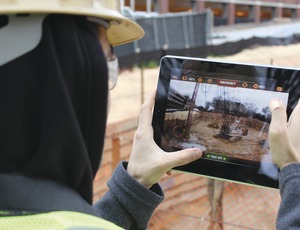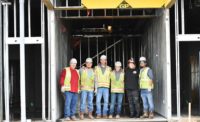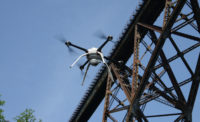

Unmanned aerial vehicles, also known as drones, are rising in use on construction spots around the globe, aviation experts say. Technology advances and mobile devices have made unmanned aerial vehicles, or UAVs, much easier to manage. Also, drones are a cost-effective way to check a project's progress or help jobsite managers see higher elevations or hard-to-reach spots for inspections.
Their use is also on the rise as the Federal Aviation Administration prepares to select six testing sites in the U.S. that will help determine more rules for commercial use of UAVs. The FAA modernization act of 2012 requires it to create safety rules to allow UAVs into commercial airspace by 2015.
Although they have raised many privacy issues in the U.S., drones have great potential on jobsites. As long as UAVs are flown at 400 feet or below and weigh less than 4.4 pounds, they qualify for hobby use, a status that doesn't require the lengthy, 24-month permitting process required by the FAA for larger UAVs in U.S. airspace.
"We see them utilized quite a bit for construction," says Kevin Lauscher, a training specialist with Canada-based Draganfly Innovations, which provides the smaller UAVs to public agencies and for use in construction.
One client deployed them to inspect joint sealants on a 20-floor office project, Lauscher adds. "We see their use anywhere an elevated view is needed in the construction process," he adds. Construction has long used full-sized aircraft and small helicopters to inspect bridges, scaffolding and cranes, he notes. However, UAVs have evolved into a simple means of collecting progress shots.
Researchers are ramping up their work with UAVs, too. The FAA has authorized 25 universities to fly drones in U.S. airspace. Some licenses are more active and some have expired, according to documents the FAA has released. At the Georgia Institute of Technology, Javier Irizarry, an assistant professor at the School of Building and Construction, landed a $74,984 grant from the Federal Highway Administration and the Georgia Dept. of Transportation (GDOT) to evaluate the potential uses of UAVs, such as surveying and bridge inspections.
Irizarry—who is also director of the school's CONECTech Lab, which researches apps and other technology uses in construction—says the research team will be working on the project with Eric Johnson, an associate professor in the Georgia Institute of Technology's School of Aerospace Engineering, whose research on guidance, navigation, and control work for unmanned system spans close to 20 years, school officials say.
The first test, which kicked off on Feb. 25, involves using UAVs on the school's Engineered BioSystems Building project, which is being managed by contractor McCarthy Building Cos. No workers were on the site during the test, which involved getting the drone close to the bottom of an excavation wall.
"Right now, we're looking at the foundation work of the job," Irizarry says. Eventually, the team will investigate the different stages, such as concrete placement and first-level construction of the building. The team is using a $300 UAV that can climb 100 ft; the drone is manufactured by French electronics company Parrot.
"We are looking at different versions of controls without line-of-sight navigation," Irizarry adds. The team plans to test and gather data about the devices to discover their best applications. Over a year and a half, the tests will be conducted with GDOT divisions to determine which areas of the agency's oversight have the best potential to implement UAV technology.
Georgia Tech is just one of many universities around the U.S. that are ramping up their research into drones and is keen to be one of the testing sites set up under the FAA's watch. "Establishing one of these sites in the State of Georgia would provide an opportunity to explore the benefits and capabilities of UAVs for the operations and practices within the Georgia Department of Transportation (GDOT)," says the research team. The FAA's most recent call for proposals can be seen in this PDF.




Post a comment to this article
Report Abusive Comment